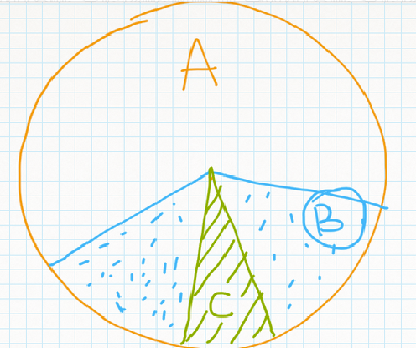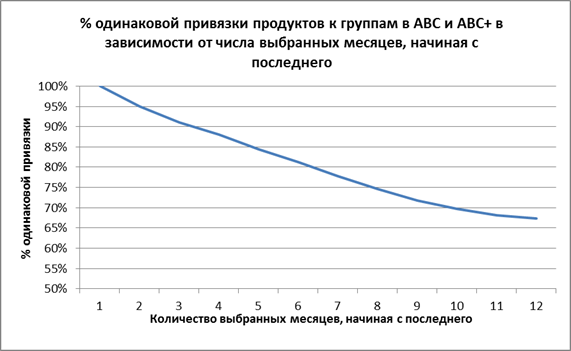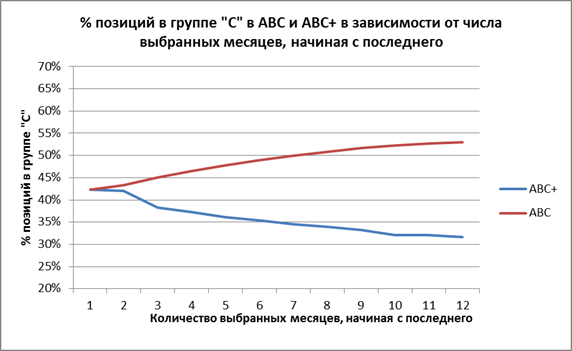Modification of ABC analysis, or how to make a bad one work a little better

Introduction
ABC analysis is as old an instrument of marketers as it is clumsy. From the point of view of real data analysis, it is unlikely to be of interest. However, many time-saving, and sometimes simply not possessing other methods of studying the assortment matrix, resort to such a simple and in fact clumsy “ABC” analysis.
Ease of use and understanding is what catches the layman. In this article I will talk about how I modified the ABC analysis for those who did not need to comprehend the subtleties and features of statistics and data analysis in the workflow. I work as an analyst in a restaurant holding and specialize in multi-format establishments, so the examples will be relevant.
It so happened organizationally that the chefs of various institutions have long used ABC as a tool for selecting dishes in the formation of the menu. In this case, absolutely no attention was paid to what period is chosen (from several weeks to six months).
As a result, some dishes introduced on the menu as special offers for a short period simply could not compete with dishes sold regularly. This happened for the reason that if you select a period of 3 months and salad X is sold all 3 months, and a new salad Y is only 1, then salad X is much more likely to get into group A or B than salad Y.
Fighting the flaw and see what happens
The idea of modifying ABC (let's call it “ABC +”) is to calculate for each position which group it belongs to, taking into account only the period when it was sold. That is, if this is a new product, or vice versa, it was removed from the menu not so long ago, and also if there were interruptions in the supply of ingredients, such an analysis will give a more correct estimate for the sales of this product.
To show the differences between ABC and its modifications, for example, in the Excel package we will create 1,500 products, the sale of which per month is from 1 to 20 thousand rubles. Moreover, each product appears from the 1st to the 12th month. Those. a situation will be set when different items appear in the menu at different times and are not withdrawn from sales.
We apply to the data ABC and ABC + analysis with boundaries A up to 50% of the cumulative (cumulative) total, B up to 80% (all that is higher is group C). Other gradations may be applied. At the same time, calculating in ABC + an array for each product, including the amount of its turnover and the amount of turnover for all other products sold in the same periods. From this array, it is calculated which group the product belongs to. A total of 1,500 arrays are created (i.e., a 1500X1500 matrix). Compare the results obtained using ABC and ABC +. First, we calculate how often products are in the same groups in different models, depending on the number of months chosen (from the most recent).

As you can see from the graph, choosing one last month, ABC + completely duplicates ABC. But looking at wider time intervals, the similarity between the two instruments gradually disappears. The reason for the difference is that with increasing periods, ABC more and more differentiates the group of products that are sold on a regular basis with high turnover. At the same time, ABC +, by contrast, maximizes the potential of dishes, regardless of the number of periods. For example, let’s show how% of products in group C change in different models with a change in the periods taken.

Output
In this example, on a simplified model, it was demonstrated how, by modifying the ABC tool, it is possible to “smooth out” the problem that arises when items sold during a non-selected interval are included in the analysis. Such a tool is more suitable for employees whose responsibilities do not directly include knowledge of statistics, but which are included in the decision-making process on the introduction or withdrawal of products from sale.
Of course, ABC is a tool that can work with any type of metric data. It is not so important whether it is a breakdown of goods, customers, expenses. However, like the usual ABC, the modification also has a number of disadvantages, namely: it does not work with seasonality, is sensitive to a small number of observations, and it does not completely eliminate the principle of “the rich becomes richer”, i.e. when the product is so loved by the customer that its popularity provides even greater popularity in the future. In addition, like ABC, ABC + is better to use on a large number of data and with a large assortment matrix, additionally calculating XYZ analysis.
In conclusion, I would like to add that after the integration of ABC + in the menu of several cafes, dishes were added again, which were considered not promising according to the results of ABC analysis.
